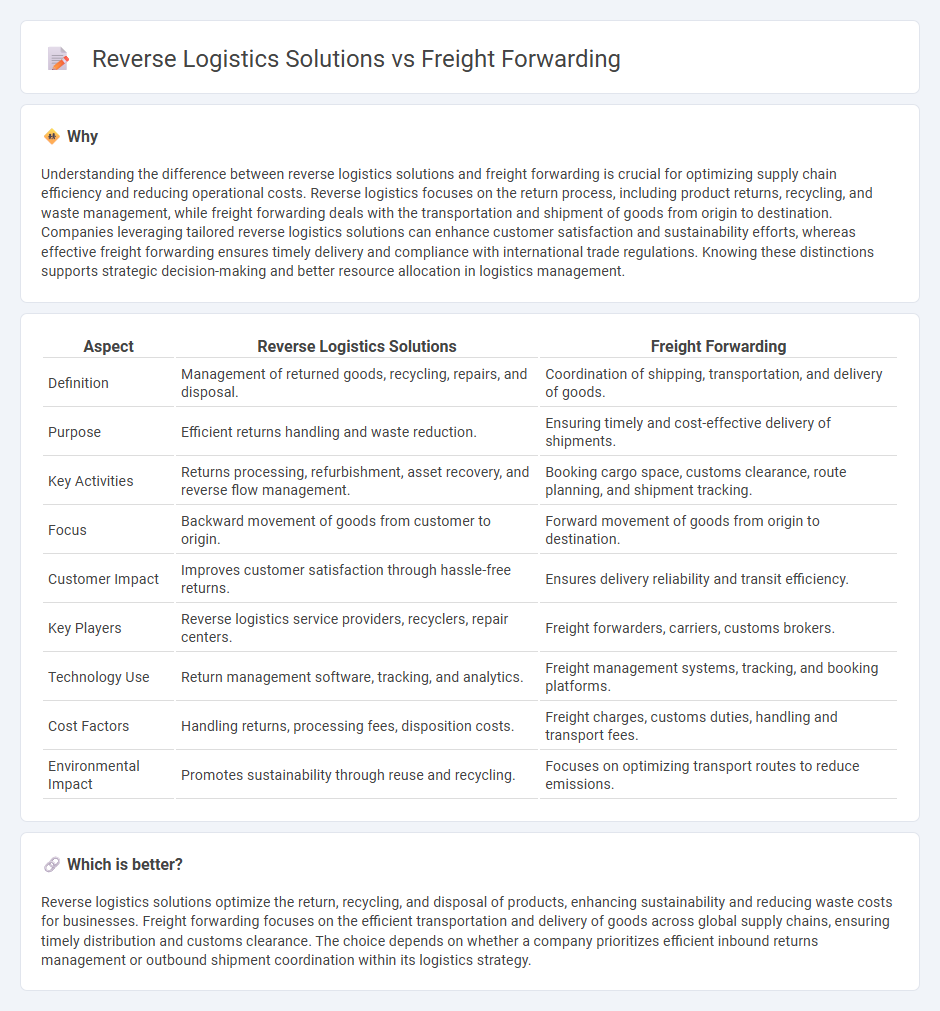
Reverse logistics solutions focus on the efficient return and recycling of products, minimizing waste and reducing environmental impact, whereas freight forwarding emphasizes the strategic coordination of shipments from origin to destination, ensuring timely delivery and cost efficiency. Companies investing in reverse logistics improve customer satisfaction and regulatory compliance by managing returns, repairs, and disposal effectively, while freight forwarders optimize supply chain operations through carrier selection and route planning. Discover how integrating both approaches can transform your supply chain by exploring innovative logistics strategies.
Why it is important
Understanding the difference between reverse logistics solutions and freight forwarding is crucial for optimizing supply chain efficiency and reducing operational costs. Reverse logistics focuses on the return process, including product returns, recycling, and waste management, while freight forwarding deals with the transportation and shipment of goods from origin to destination. Companies leveraging tailored reverse logistics solutions can enhance customer satisfaction and sustainability efforts, whereas effective freight forwarding ensures timely delivery and compliance with international trade regulations. Knowing these distinctions supports strategic decision-making and better resource allocation in logistics management.
Comparison Table
| Aspect | Reverse Logistics Solutions | Freight Forwarding |
|---|---|---|
| Definition | Management of returned goods, recycling, repairs, and disposal. | Coordination of shipping, transportation, and delivery of goods. |
| Purpose | Efficient returns handling and waste reduction. | Ensuring timely and cost-effective delivery of shipments. |
| Key Activities | Returns processing, refurbishment, asset recovery, and reverse flow management. | Booking cargo space, customs clearance, route planning, and shipment tracking. |
| Focus | Backward movement of goods from customer to origin. | Forward movement of goods from origin to destination. |
| Customer Impact | Improves customer satisfaction through hassle-free returns. | Ensures delivery reliability and transit efficiency. |
| Key Players | Reverse logistics service providers, recyclers, repair centers. | Freight forwarders, carriers, customs brokers. |
| Technology Use | Return management software, tracking, and analytics. | Freight management systems, tracking, and booking platforms. |
| Cost Factors | Handling returns, processing fees, disposition costs. | Freight charges, customs duties, handling and transport fees. |
| Environmental Impact | Promotes sustainability through reuse and recycling. | Focuses on optimizing transport routes to reduce emissions. |
Which is better?
Reverse logistics solutions optimize the return, recycling, and disposal of products, enhancing sustainability and reducing waste costs for businesses. Freight forwarding focuses on the efficient transportation and delivery of goods across global supply chains, ensuring timely distribution and customs clearance. The choice depends on whether a company prioritizes efficient inbound returns management or outbound shipment coordination within its logistics strategy.
Connection
Reverse logistics solutions and freight forwarding are interconnected through the efficient management of product returns, recycling, and repurposing within the supply chain. Freight forwarding companies coordinate transportation and documentation for returned goods, ensuring timely and cost-effective reverse flow operations. Optimizing reverse logistics enhances sustainability and reduces waste, while freight forwarding facilitates seamless movement across international borders and logistics networks.
Key Terms
**Freight Forwarding:**
Freight forwarding involves managing the movement of goods from origin to destination through various transportation modes, ensuring efficient customs clearance and regulatory compliance. This service optimizes supply chains by coordinating carrier bookings, documentation, and tracking, reducing transit times and costs for businesses. Explore more to understand how freight forwarding can enhance your logistics operations.
Customs Clearance
Freight forwarding focuses on efficient shipping and Customs clearance for inbound and outbound goods, ensuring compliance with international trade regulations and minimizing delays. Reverse logistics solutions prioritize managing returns, repackaging, and inspection processes while navigating Customs procedures to handle product recalls or end-of-life goods. Explore our comprehensive insights to understand the distinct Customs clearance strategies essential in both freight forwarding and reverse logistics operations.
Shipping Documentation
Freight forwarding primarily involves managing shipping documentation such as bills of lading, export declarations, and customs paperwork to ensure smooth international transport of goods. Reverse logistics solutions require specialized documentation like return authorizations and condition reports to handle product returns and refurbishment efficiently. Explore in-depth how accurate shipping documentation impacts both freight forwarding and reverse logistics processes.
Source and External Links
What is freight forwarding? | Clarksons - Freight forwarding is the strategic planning and coordination of the international movement of goods via air, sea, rail, and/or highway, with freight forwarders acting as intermediaries ensuring shipments are transported efficiently and comply with customs regulations.
What Is Freight Forwarding? Definition, Benefits and Key Stages - Freight forwarding involves stages like export haulage, customs clearance, and origin handling, where freight forwarders manage transportation logistics, customs checks, and inspection of goods to ensure safe and legal shipment.
About Freight Forwarding - FIATA - Freight forwarding encompasses services related to carriage, consolidation, storage, packing, customs matters, insurance, and supply chain management to ensure goods arrive timely, in good condition, and at economical cost from origin to destination.
 dowidth.com
dowidth.com